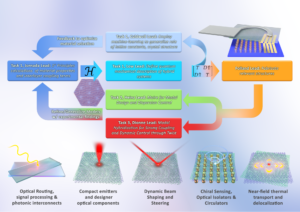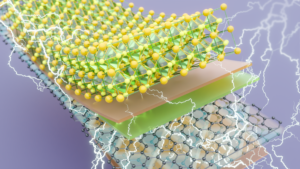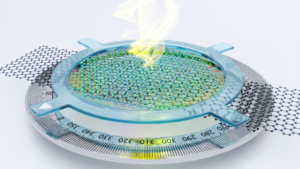Tasks Overview:

Task 1:
A machine-learning algorithm will be developed to identify the generalized requirements in lattice properties that result in, and optimize the emergence of moiré and twist-optic phenomena (Jornada, Caldwell). The algorithm will employ first principles calculations of materials and their quantum interlayer couplings (Task 1, Jornada Lead) to modify the general tensorial bianisotropic optical coefficients of the twisted structures. Optical coefficients and their mapping to specific electromagnetic phenomena (Low) will enable closedloop interactions between bottom-up materials design, and novel device innovations. These theoretical findings will serve to generalize our understanding of the underlying lattice structures, mismatches and misorientations that are suitable for realizing novel moiré symmetries.

Task 2:
We will seek to amplify optical nonlinearities, engineer material and photonic dispersion for novel gain and lasing concepts, explore the potential for lossless polaritonic modes, and coordinate these findings into hierarchical moiré structures featuring nested band configurations.

Task 3:
Task 3 strives to understand and control phenomena that emerge from hybrid Moire heterostructures – including coupling between van der Waals stacks; coupling with bulk substrates; and coupling with metasurface lattices and metamaterials. Members of this task are tackling 4 critical research directions. First, we are exploring polaritonic strong coupling and how this can be mediated through twist, giving rise to control over optical coherence and polarization (subtask 3.1). Second, we are looking at how novel phenomena observed within highly anisotropic, low-symmetry lattices are influenced through interlayer twist, with a focus on how such effects can be used to control modal dispersion (subtask 3.2). Third, we are realizing and controlling optical chirality through twist-optic design (subtask 3.3). Finally, we are designing and leveraging actively tunable material and metasurface platforms integrated into twist-optic structures to realize dynamic control of these critical optical functions (subtask 3.4).

Fabrication:
Novel automated fabrication and layer stacking tools will be developed (Folland) to realize the structure. Our proposed work focuses on photonic technologies across the electromagnetic spectrum, which are of critical relevance to the DoD. The bottom-up quantum design of bianisotropic twisted atomic stacks would allow the engineering of unprecedented, twist and gate tunable electric, magnetic and magneto-optical susceptibilities, in otherwise purely electronic atomic constituents.
In this program we are expanding and generalize the current state of the art in twist optic fabrication to operate with both 2D and 3D membranes and bulk materials or metasurfaces. Our program will develop (1) accurate non-destructive methods of determining orientation of twisted structures (2) accurate methods of determining twist angle during transfer and (3) implementing automation tools to increase process scalability and reliability, working closely with the US Naval Research Laboratory.
The first step in our general process flow is sample preparation for twisting, which includes the exfoliation of materials and any associated metasurface patterning , using conventional nanofabrication techniques. Second, we will accurately determine the orientation of the lattice within a fraction of a degree using a combination of optical microscopy, polarized SHG, Raman spectroscopy, or electron microscopy techniques. We will develop an image processing routine for identifying the crystal facet position from optical spectroscopy and employ an automated polarizer-analyzer setup to quickly and efficiently determine crystal orientation. Third, we will perform vdW stacking, where we are developing new alignment processes in order to be able to track the stacking process with sub-degree accuracy. The goal is to develop easily machine-readable alignment marks, that give the relative twist angle separation in real time as the structure is fabricated. The development of such markers will also enable the creation of fully automated computational algorithms for fabricating twist optic structures, which will allow for the potential of multilayer (n>3) structures, which are currently impossible to fabricate due to low yields in user processes. At the end of the program we aim to provide a pipeline and routine for general purpose twist-optic fabrication, spurring further research in this area.
